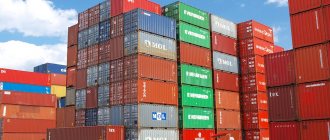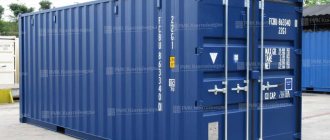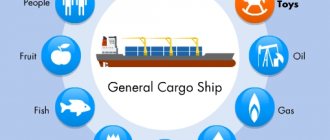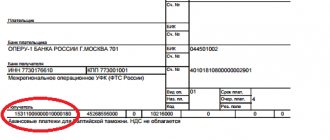A sea container is a standardized reusable container designed for transporting goods by sea. The container is designed in such a way that it can be easily reloaded both in the port to the shore and to other ships. This is facilitated by the universal form, which is widely used by all manufacturers.
The container is a steel cube with a volume of 10.4 m3. The entrance is locked with reliable locking mechanisms. Two doors allow you to open the passage as wide as possible, thereby facilitating the loading of materials. The floor is a corrugated sheet of iron 5 mm thick.
This type of packaging is in quite high demand both among international companies and private entrepreneurs.
Select the type you need: 10ft20ft30ft40ft45ft
Decoding abbreviations
- Open Top (OT) – a special model with a “folding” canvas awning;
- Dry Cube (DC) – standard universal (dry cargo) models of type 1СС or 1АА;
- High Cube (HC) – a high container with increased capacity, type 1CCC or 1AAA;
- High Cube Pallet Wide (HCPW) - tall and wide with maximum volume;
- Super High Cube (SHC) - the highest possible container;
- Flat Rack (FR) - platform container with limiters;
- Bulk - for bulk cargo, with convenient hatches on the roof for loading and a small hatch at the base for unloading;
- Double Door (DD) - a large container with doors at both ends;
- High Cube Hard Top (HCHT) - a high container with a hard removable roof;
- Pallet Wide (PW) is a box with an increased (compared to DC) internal width, which allows you to accommodate 2 Euro pallets.
Detailed information about classification in our material: Types and types of containers.
Types of containers according to ISO-688 standard
The standard identifies three main types of transport containers:
- General purpose containers
- Special purpose containers: ventilated, open top or side, platform containers
- Containers for special cargo: isothermal, refrigerated, heated container, tank containers, containers for bulk cargo, etc.
Sizes and dimensions of 10 foot containers
Marine containers with a capacity of 1/2 TEU (10 feet) are similar in size to standard five-ton railway containers of the Soviet Union. Unlike the latter, they are characterized by complete tightness, good resistance to physical impact and greater structural rigidity.
In practice, most companies sell twin 1/2 TEU, outwardly they resemble a twenty-foot one, but with a double door system, this is due to the fact that it is more convenient to form two 10-foot containers in different batches than to bundle it with a mixed product of 1 TEU. It can also be noted that they are quite often purchased by private entrepreneurs for storage space.
Go to the selection of new and used 10ft containers
| Options | 10′ Standard (DC) | 10′ High (HC) |
| External dimensions, mm | ||
| Length | 3056 | 3056 |
| Width | 2438 | 2438 |
| Height | 2591 | 2896 |
| Internal dimensions, mm | ||
| Length | 2887 | 2887 |
| Width | 2350 | 2350 |
| Height | 2390 | 2698 |
| Doorway dimensions, mm | ||
| Width | 2336 | 2336 |
| Height | 2291 | 2598 |
| Other characteristics | ||
| Maximum load capacity, kg | up to 22000 | up to 28000 |
| Number of Euro pallets that can be accommodated | 5 | 5 |
| Tare weight (weight), kg | 1200 | 1200 |
| Internal volume, m3 | 16,5 | 18,7 |
Container markings
Due to the fact that the container is a transport equipment for transporting goods not only within one country, but also between states, it must not only be standard in terms of size, but also safe during transportation. This is achieved by its design, materials used and strength. To confirm this, the container is affixed with a CSC Convention placard, which is issued by the qualification and regulatory authority of the country of origin (if any) or another country. A container with such a label is considered to be certified for safety by countries that have signed the CSC. The CSC Safety Approval label is affixed to the left door of the container, usually at the bottom. The following information must be reflected on the plate:
- The country that granted the approval and the number of the approval (the country that granted the approval must be identified by the distinctive sign used to indicate the country of registration of motor vehicles in international traffic);
- Date (month and year) of manufacture;
- The identification number of the container assigned by the manufacturer, or for existing containers for which this number is unknown, the number assigned by the administration;
- Maximum operating gross weight (kilograms and pounds);
- Allowable stacking weight at 1.8 g (kilograms and pounds), where g is the acceleration due to gravity;
- Transverse structural stiffness test load magnitude (kilograms and pounds);
- End wall strength (indicated on the plate only if the end walls are designed to withstand a load less than or greater than 0.4 of the maximum permissible payload, i.e. 0.4 R);
- Side wall strength (indicated on the plate only if the side walls are designed to withstand a load less than or greater than 0.6 of the maximum permissible payload, i.e. 0.6 R);
- The date (month and year) of the first maintenance inspection for new containers and the date (month and year) of subsequent maintenance inspections if the label is used for this purpose. The scope and methods of mandatory testing of containers are contained in ISO 1496 standards.
In order to ensure unhindered and safe transportation of goods in international traffic through border crossings, the container is equipped with a plate (Approved For Transport Under Customs Seal), indicating approval for transportation with customs seals. The plate confirms the compliance of a large-capacity container with the requirements of the Customs Convention regarding containers and is mandatory when transporting goods in large-capacity containers in international traffic.
The container may also contain signs with information about the manufacturer, owner and operator of the container, and the timing (month and year) of the next major overhaul (including on the side walls of the container).
Usually all the signs are combined in one place. Examples and types of plates are shown in this figure.
Symbol for identifying a container used for transportation by air and land. The symbol must be located in the upper left corners of the end walls and adjacent roof corners, as well as in the upper left corners of the side walls of the container. The symbol color must be black. If the color of the container itself is black, it is necessary to use a panel of a corresponding color as the background, preferably white.
Electrical shock warning sign. Containers equipped with side ladders must display an electrical hazard sign - a black symbol on a yellow background surrounded by a black border. The sign should be located near the stairs.
Container height sign greater than 2.6 m (8 ft 6 in) in height. Containers over 2.6 m (8 ft 6 in) in height are marked as follows:
- the height sign is applied on both sides of the container;
- Alternating black and yellow stripes shall be located on the top members of each end frame and side walls adjacent to the corner fitting.
Container height signs greater than 2.6 m (8 ft 6 in) contain groups of black numbers on a yellow background, surrounded by a black border. The upper group of numbers indicates the height of the container in meters with an accuracy of one tenth, the value of which must be no less than the actual height. The lower group of numbers indicates the height in feet, accurate to the nearest foot, the value of which must be no less than the actual height.
Other marks may be applied to the container depending on the operating conditions and the nature of the cargo (for example, dangerous goods).
Sizes and dimensions of 20 foot containers
The material for creating this type of container is three-millimeter sheets of profile steel. Stiffening ribs obtained by cold rolling of steel prevent physical deformation of a 20-foot container. Coating with an anti-corrosion solution helps protect against the harmful effects of external factors, such as high humidity and temperature changes. The floors are made of steel beams and specially treated timber bars, thanks to this combination the floor can withstand enormous loads.
Go to the selection of 20ft shipping containers
| Options | 20′ DC | 20′HC | 20′ OT | 20′HT | 20′DD | 20′ PW | 20′ HCPW | 20′ SD |
| External dimensions, mm | ||||||||
| Length | 6058 | 6058 | 6058 | 6058 | 6058 | 6058 | 6058 | 6058 |
| Width | 2438 | 2438 | 2438 | 2438 | 2438 | 2500 | 2500 | 2438 |
| Height | 2591 | 2896 | 2591 | 2591 | 2591 | 2591 | 2896 | 2591 |
| Internal dimensions, mm | ||||||||
| Length | 5905 | 5905 | 5905 | 5905 | 5905 | 5905 | 5905 | 5905 |
| Width | 2350 | 230 | 2350 | 2350 | 2350 | 2440 | 2440 | 2350 |
| Height | 2350 | 2698 | 2390 | 2390 | 2390 | 2390 | 2698 | 2390 |
| Doorway dimensions, mm | ||||||||
| Width | 2336 | 2336 | 2336 | 2336 | 2336 | 2374 | 2374 | 2336 |
| Height | 2291 | 2597 | 2291 | 2291 | 2291 | 2291 | 2597 | 2291 |
| Other characteristics | ||||||||
| Maximum load capacity, kg | up to 30000 | up to 30000 | up to 30000 | up to 30000 | up to 30000 | up to 30000 | up to 30000 | up to 30000 |
| Number of Euro pallets that can be accommodated | 11 | 11 | 11 | 11 | 11 | 15 | 15 | 11 |
| Tare weight (weight), kg | 2250 | 2350 | 2200 | 2270 | 2340 | 2350 | 2550 | 2400 |
| Internal volume, m3 | 33,2 | 37,4 | 33,2 | 33,2 | 33,2 | 34,4 | 38,9 | 33,2 |
Tank container (tank container, Tank Container)
The tank container (tank container) is designed for transportation of liquid liquid cargoes of various types: chemicals, food products, liquefied gases, petroleum products, etc.
A tank container is a tank mounted in a metal frame of standard dimensions, which allows the tank to be used as a universal 20-foot unit for transportation on various types of transport and storage. The size, volume, weight and material of the tank can vary significantly depending on the purpose of the tank container. Made from cargo-neutral materials. They are equipped with devices for unloading both by gravity and under pressure, are equipped with thermal insulation and a heating system for unloading at low temperatures, can be divided into sections or have double walls for filling with insulating substances.
Symbols used:
20-foot tank container: 20 foot Tank Container, 20 TC, 20 Tank, 20 TK
Please check with the owner for tank container dimensions, cargo capacity and lifting capacity.
Dimensions and dimensions of 30 foot containers
A 30-foot sea container is usually used for transporting large and bulky cargo. It is used to transport goods up to 9 meters in length, but this market segment belongs entirely to it. One of the main advantages of such containers is the increased height, thus, the use of such containers, with the same freight price, allows you to transport more cargo.
Go to the selection of 30ft shipping containers
| Options | 30′ DC | 30′HC |
| External dimensions, mm | ||
| Length | 9125 | 9125 |
| Width | 2438 | 2438 |
| Height | 2591 | 2896 |
| Internal dimensions, mm | ||
| Length | 8931 | 8931 |
| Width | 2350 | 2350 |
| Height | 2350 | 2698 |
| Doorway dimensions, mm | ||
| Width | 2290 | 2290 |
| Height | 2270 | 2566 |
| Other characteristics | ||
| Max. load capacity, kg | up to 28000 | up to 28000 |
| Number of Euro pallets that can be accommodated | 18 | 18 |
| Floor area, m2 | 20,5 | 20,5 |
| Tare weight (weight), kg | 2840 | 2900 |
| Internal volume, m3 | 47,0 | 55,2 |
Container weight without cargo (tons)
| A 20 foot container without load weighs | standard | 2,145-2,370 |
| high HC | 2,340 | |
| Open Top | 2,440 | |
| A 40ft container without load weighs | standard | 3,640-4,000 |
| high HC | 3,740-4,200 | |
| high, wide HCPW | 4,200-4,400 | |
| Open Top | 4,430 | |
| A 45 ft container without load weighs | high, wide HCPW | 4,180 |
| A container weighs 5 tons without cargo | standard | 1,100 |
Sizes and dimensions of 40 foot containers
A 40 foot container is suitable not only for transporting large cargo. It can also be used as a mobile warehouse for goods.
Go to the selection of 40ft shipping containers
| Options | 40′ DC | 40′HC | 40′ SHC | 40′ OT | 40′HT | 40′DD | 40′ PW | 40′ HCPW | 40′ SD |
| External dimensions, mm | |||||||||
| Length | 12192 | 12192 | 12192 | 12192 | 12192 | 12192 | 12192 | 12192 | 12192 |
| Width | 2438 | 2438 | 2438 | 2438 | 2438 | 2438 | 2500 | 2500 | 2438 |
| Height | 2591 | 2896 | 3200 | 2591 | 2591 | 2591 | 2591 | 2896 | 2591 |
| Internal dimensions, mm | |||||||||
| Length | 12045 | 12045 | 12045 | 12045 | 12045 | 12045 | 12045 | 12045 | 12045 |
| Width | 2330 | 2330 | 2330 | 2330 | 2330 | 2330 | 2420 | 2420 | 2330 |
| Height | 2350 | 2698 | 3000 | 2390 | 2390 | 2390 | 2390 | 2698 | 2390 |
| Doorway dimensions, mm | |||||||||
| Width | 2336 | 2336 | 2336 | 2336 | 2336 | 2336 | 2374 | 2374 | 2336 |
| Height | 2291 | 2597 | 2900 | 2291 | 2291 | 2291 | 2291 | 2597 | 2291 |
| Other characteristics | |||||||||
| Max. load capacity, kg | up to 30000 | up to 30000 | up to 30000 | up to 30000 | up to 30000 | up to 30000 | up to 30000 | up to 30000 | up to 30000 |
| Number of Euro pallets that can be accommodated | 24 | 24 | 24 | 24 | 24 | 24 | 30 | 30 | 24 |
| Floor area, m2 | 28,1 | 28,1 | 28,1 | 28,1 | 28,1 | 28,1 | 29,1 | 29,3 | 28,1 |
| Weight, kg | 3900 | 4200 | 4300 | 3870 | 3900 | 4100 | 4000 | 4300 | 4150 |
| Internal volume, m3 | 66,0 | 75,5 | 84,2 | 67,1 | 67,1 | 67,1 | 69,7 | 78,9 | 67,1 |
Doorway dimensions
| Container | Width | By height | |
| 20′ | standard | 2,336 | 2,291 |
| high | 2,340 | 2,597 | |
| open | 2,335 | 2,240 | |
| 40′ | standard | 2,336 | 2,291 |
| high | 2,340 | 2,597 | |
| tall, wide | 2,432 | 2,597 | |
| open top | 2,338 | 2,234 | |
| 45′ | tall, wide | 2,416 | 2,439 |
| 5 ton | standard | 1,950 | 2,100 |
Sizes and dimensions of 45 foot containers
45 foot containers are practically no different from similar products of a smaller volume, the only difference will be the dimensions of the cargo being stacked.
Go to the selection of 45ft shipping containers
| Options | 45′ DC | 45′HC | 45′ SHC | 45′ OT | 45′HT | 45′DD | 45′ PW | 45′ HCPW | 45′ SD |
| External dimensions, mm | |||||||||
| Length | 13720 | 13720 | 13720 | 13720 | 13720 | 13720 | 13720 | 13720 | 13720 |
| Width | 2438 | 2438 | 2438 | 2438 | 2438 | 2438 | 2500 | 2500 | 2438 |
| Height | 2591 | 2896 | 3200 | 2591 | 2591 | 2591 | 2591 | 2896 | 2591 |
| Internal dimensions, mm | |||||||||
| Length | 13570 | 13570 | 13570 | 13570 | 13570 | 13570 | 13570 | 13570 | 13570 |
| Width | 2330 | 2330 | 2330 | 2330 | 2330 | 2330 | 2420 | 2420 | 2330 |
| Height | 2350 | 2698 | 3000 | 2390 | 2390 | 2390 | 2390 | 2698 | 2390 |
| Doorway dimensions, mm | |||||||||
| Width | 2336 | 2336 | 2336 | 2336 | 2336 | 2336 | 2374 | 2374 | 2336 |
| Height | 2291 | 2597 | 2900 | 2291 | 2291 | 2291 | 2291 | 2597 | 2291 |
| Other characteristics | |||||||||
| Max. load capacity, kg | up to 30000 | up to 30000 | up to 30000 | up to 30000 | up to 30000 | up to 30000 | up to 30000 | up to 30000 | up to 30000 |
| Number of Euro pallets that can be accommodated | 27 | 27 | 27 | 27 | 27 | 27 | 33 | 33 | 27 |
| Number of standard pallets that can be accommodated | 24 | 24 | 24 | 24 | 24 | 24 | 26 | 26 | 24 |
| Floor area, m2 | 31,6 | 31,6 | 31,6 | 31,6 | 31,6 | 31,6 | 32,8 | 32,9 | 31,6 |
| Weight, kg | 4650 | 4800 | 4850 | 4650 | 4650 | 4700 | 4700 | 4950 | 4750 |
| Internal volume, m3 | 74,3 | 85,3 | 94,9 | 75,6 | 75,6 | 75,6 | 78,5 | 88,9 | 75,6 |
Weight Limit
| Model type | Tons | |
| Sea container weight 20 feet | standard | 24,000-30,480 |
| high (HC) | 30,480 | |
| open (Open Top) | 24,000 | |
| Sea container weight 40 feet | standard | 28,800-30,480 |
| high (HC) | 30,480-32,500 | |
| high, wide (HCPW) | 30,480-35,000 | |
| Open Top | 36,000 | |
| Sea container weight 45 feet | high, wide (HCPW) | 34,000 |
| Sea container weight 5 tons | standard | 5,000 |
Loading capacity of sea containers (capacity)
| Container type | Tons | |
| Container capacity 20 feet | standard | 21,630-28,335 |
| high | 28,140 | |
| Open Top | 21,560 | |
| Sea container 40 feet loading capacity | standard | 24,800-26,840 |
| high | 26,280-28,650 | |
| tall, wide | 26,280-30,720 | |
| open (Open Top) | 31,570 | |
| Sea container 45 feet | tall, wide | 29,820 |
| Container capacity 5 tons | standard | 3,900 |
Dividing containers into types
Containers are divided into types according to the following criteria:
- appointment;
- design features;
- gross and net weight;
- sphere of circulation;
- created conditions for cargo.
Each classification is given in detail below.
Purpose of containers
According to this parameter, containers are divided into the following types:
- Universal. Cargo tanks suitable for transporting a wide variety of piece and packaged cargo, as well as large cargo units.
- Specialized. Their design clearly corresponds to the characteristics of the goods being transported: liquid, bulk or gaseous. This category also includes containers that provide proper temperature conditions for goods.
Container design
According to this parameter, the containers differ in:
- covered (the cargo in them is protected from wind and light rain);
- open (they transport goods that do not deteriorate in any weather conditions);
- unsealed;
- waterproof (designed for transporting goods for which rain penetration is undesirable);
- made of metal;
- consisting of a metal frame and a polymer coating.
Container weight (gross and net)
Here the classification is based on ISO recommendations. Containers weighing 20 tons and 30 tons, with a constant width of 8 feet, which is 2.438 m, are widely in demand.
The heights of the containers vary as follows:
- 8 feet;
- 8.5 feet (2.59 meters);
- 9 feet (2.74 meters);
- 9.5 feet (2.89 meters).
Scope of container circulation
This criterion divides containers into the following types:
– international application
— mainline;
— allowed within the territory of one state for transportation by several types of transport;
- in-plant.
Created conditions inside the container
Cargo is placed in containers in such a way that optimal conditions for their transportation are created.
- Refrigerated containers. They contain refrigeration units, and they themselves are made of a thermally insulated body. Any temperature from -250C to +250C is created inside them. The unit directs air flows of the required temperature to the floor, from which, thanks to its T-shaped profile, they are distributed throughout the entire container.
- Universal containers. They are completely sealed, have rigid ends, roof and side sides. There is a hinged door at the end for easy loading and unloading.
- Ventilated containers. Designed for transporting goods that require ventilation. These include cocoa beans, coffee beans, and spices. Air flows circulate naturally or forcedly.
- Container tanks. They transport liquefied gases and other substances in a liquid state. This category includes food liquids (milk), which are dangerous and poisonous. These containers look like cylindrical tanks, and they are suitable for transportation by sea and land.
- Platform containers. They are used for transporting large and non-bulk cargo: building materials, rolled metal, equipment. The platform base is supplemented with corner fittings.
Container 40 feet of increased volume (High Cube)
The name of this type of container speaks for itself. Translated from English, “High Cube” means “high cube,” which characterizes the increased height parameter in structures. Sometimes the abbreviation "HQ" is also found, which means the same as NS. The overall dimensions of the High Cube sea container differ from the usual 40-foot container by its height, which is 2.896 meters. The design holds a larger volume and can be used for different types of cargo, light but bulky or high, but not exceeding the capacity of the container.
Regardless of the nature of the objects being transported, there is a container for any of them, even the most demanding in terms of storage conditions or non-standard in size; the variety of sizes and shapes allows you to choose it to suit any needs. At the same time, modern technologies for manufacturing boxes will ensure protection of cargo from external influences, and sealing methods will protect against possible theft. All these factors, combined with the professionalism of the carrier, make it possible to carry out high-quality delivery of objects to various parts of the country and abroad.
Share your opinion in the comments regarding the transportation of goods in sea containers.






